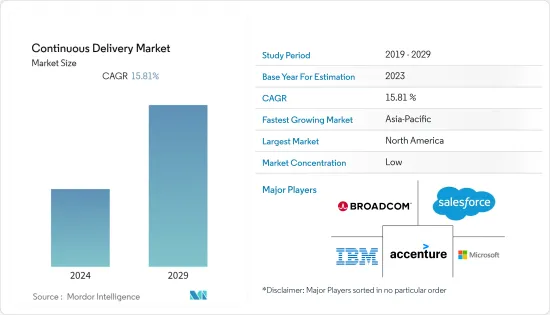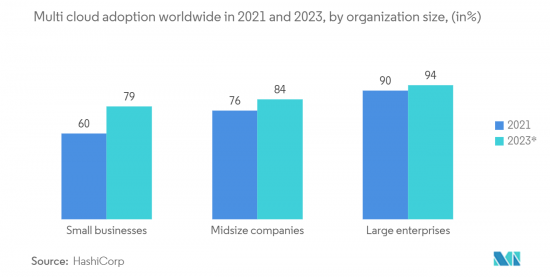 |
市場調查報告書
商品編碼
1404441
持續交付 -市場佔有率分析、產業趨勢與統計、2024-2029 年成長預測Continuous Delivery - Market Share Analysis, Industry Trends & Statistics, Growth Forecasts 2024 - 2029 |
||||||
※ 本網頁內容可能與最新版本有所差異。詳細情況請與我們聯繫。
本會計年度持續交付市場規模預估為34.8億美元,複合年成長率為15.81%,預計五年內將達84.7億美元。
據美國軟體開發公司 Perforce Software, Inc. 稱,65% 的管理員、軟體開發人員和高階主管表示,他們的組織已開始使用持續交付。

主要亮點
- 持續交付市場正在迅速擴張,主要受到人工智慧 (AI) 和機器學習 (ML) 成長的推動。隨著連網型基礎設施的快速部署和數位設備自主性的不斷增強,人工智慧/機器學習驅動的技術正在改變軟體開發流程。這些技術支援自我複製系統、自動化測試、預測部署結果、改進發布計劃並提供智慧監控和警報。
- 此外,敏捷開發方法越來越受歡迎,因為它們允許更快、更靈活地交付軟體。持續交付與敏捷原則非常一致,即軟體以小增量更新,而不是定期大規模發布。據澳洲軟體公司 Atlassian Corporation 稱,美國至少 71% 的組織使用敏捷。此外,舉措專案的成功率為 49%,而敏捷計劃的成功率為 64%。敏捷計劃的成功率比瀑布計劃高1.5倍。
- 擴大採用雲端處理和基礎設施即程式碼,使基礎設施管理更具可擴展性和適應性。持續交付使企業能夠使用雲端平台和基礎設施即程式碼工具在雲端配置中快速部署和管理應用程式。持續交付 CI/CD 管道是一個自動化流程,使企業和組織能夠快速可靠地建置、測試和部署軟體。雲端基礎架構提供了一個靈活、可擴展的平台來運行這些流程,使企業能夠適應不斷變化的需求並最佳化資源使用。這些工具可協助組織透過多種重要方式實現更高的業務敏捷性。
- 然而,開放原始碼持續交付計劃和工具將主導商業持續交付工具領域,並推動服務持續交付市場的成長。持續交付市場幫助企業和企業改變他們提供服務和營運業務的方式,以更加準確、節省成本並提高生產力。它還會產生大量有用的資訊,幫助您做出更好、更快的決策。這些資訊可以幫助您最佳化目前的流程和營運,並預測何時、何地以及如何提供最佳產品和服務。
- 然而,持續的市場擴張可能需要改進,因為公司不願意接受變革並將新技術整合到現有流程和工具鏈中。許多公司需要協助使用 DevOps 和持續交付解決方案來實施全自動技術。
- COVID-19 的爆發加速了多家公司的數位轉型工作。組織必須適應遠端工作並快速交付軟體更改,以滿足不斷變化的消費者期望。持續交付對於促進此類變革同時保持業務連續性至關重要。
持續交付市場趨勢
持續交付市場更多採用雲端技術
- 在雲端部署持續交付工具可提供更大的可擴充性、彈性以及具有定義權限的共用功能。那些建立持續交付工具的人正在利用這個機會佔領市場一角。
- 持續交付工具提供 DevOps 功能,讓團隊在雲端中在一處協作、開發、測試、部署和管理軟體。這允許最終用戶訪問雲端中的任何內容並建立新的應用程式。
- 隨著大多數企業將資料轉移到雲端,行業參與者正在開發雲端基礎的解決方案並開拓市場機會。這可能會支持未來幾年的市場成長。
- Google 宣布推出 Cloud Build,這是一個完全託管的持續交付和整合平台,可協助您快速、大規模地建置、測試和部署軟體。此外,該公司正在投資雲端處理,預計這將在未來幾年推動市場成長。
- 例如,今年,亞馬遜公司的雲端處理部門亞馬遜網路服務(AWS)宣布了在印度的重大投資計畫。該公司今年計劃投資金額1.6 兆印度盧比(130 億美元)。印度對雲端服務不斷成長的需求是巨額投資背後的推動力。這項投資將主要集中在擴大和加強全國範圍內的AWS雲端基礎設施。
- 公共雲端使企業能夠更快、更有效地改變和執行業務,以回應市場變化。提高技術的可用性。現在可以以以前從未想過的方式創造令人難以置信的引人入勝的消費者體驗。
- 雲端的採用導致人們和組織改變他們的行為和一些業務線,以克服技術限制來完成工作。雲端趨勢影響組織如何規劃投資、制定數位業務決策、選擇供應商和選擇技術。
- 持續交付市場的突出趨勢之一是發布管理、規劃和發布自動化工具,其中 DevOps 應用程式和工具有助於將軟體部署到公共雲端雲和私有雲端。例如,發布自動化工具可讓員工輕鬆設定部署配置模板,從而節省時間。

北美佔據主要市場佔有率
- 由於美國是雲端基礎的技術和物聯網的早期採用者,預計北美地區的需求將成長最快。然而,提高彈性、敏捷性和實施新應用程式的能力所帶來的好處是至關重要的。
- 此外,北美地區的企業擴大採用雲端基礎的應用程式,估計美國近35%的中小企業已經實施了雲端解決方案。北美正在經歷一系列的合併、聯盟和收購,以利用這一機會。例如,Sltix 與 Autodeploy 合作,將其持續部署和交付軟體套件推向歐洲市場。
- 機器學習 (ML)、人工智慧 (AI)、預測性和規範性分析等新技術的興起,以及這些新技術與持續交付模型、規則、自學習、資料集和推理引擎的整合。就能業務得更加順利。
- 這些投資的一個關鍵促進因素是新技術的不斷發展,以利用以前被認為是商業性的產量。這些投資預計將推動北美零售、醫療、通訊和製造應用領域的龐大市場佔有率。
持續交付產業概述
持續交付市場是分散的。隨著新技術的採用,許多參與企業憑藉著技術創新和發展進入市場,加劇了市場競爭。主要參與企業包括IBM公司、微軟公司、埃森哲PLC、Salesforce Inc.、Wipro Limited、CA Technologies(博通公司)、XebiaLabs(DIGITAL.AI)、Electric Cloud Inc. CloudBees Inc.、Red Hat Inc.、Atlassian等。
2022年10月,英特爾公司和Alphabet公司旗下的Google雲端宣布推出一款共同設計的晶片,讓資料中心更安全、更有效率。谷歌繼續其為資料中心營運自訂晶片的趨勢。分析師表示,自訂設計的晶片是一種持續的趨勢,將加速裸機的採用。
2022 年 12 月,Salesforce Inc. 宣佈在其基礎架構上推出低程式碼 DevOps Center 服務,為開發人員提供建置自訂應用程式的意見平台。 Salesforce DevOps Center 服務是基於 Salesforce 用於建立應用程式的相同物件模型。此外,到 2023 年,Salesforce 將在平台中建立更強大的持續整合/持續交付 (CI/CD) 功能,以簡化自訂應用程式在 Salesforce 平台上的部署。
其他福利:
- Excel 格式的市場預測 (ME) 表
- 3 個月分析師支持
目錄
第1章簡介
- 研究假設和市場定義
- 調查範圍
第2章調查方法
第3章執行摘要
第4章市場動態
- 市場概況
- 市場促進因素
- 跨業務流程的自動化需求不斷成長
- 更多採用雲端技術
- 市場抑制因素
- 維護資料安全和隱私
- 產業價值鏈分析
- 產業吸引力-波特五力分析
- 供應商的議價能力
- 買家/消費者的議價能力
- 新進入者的威脅
- 替代品的威脅
- 競爭公司之間敵對關係的強度
- 評估 COVID-19 對產業的影響
第5章市場區隔
- 部署類型
- 雲
- 本地
- 組織規模
- 主要企業
- 中小企業
- 最終用戶產業
- BFSI
- 通訊/IT
- 零售/消費品
- 醫學生命科學
- 製造業
- 政府/國防
- 其他最終用戶產業
- 地區
- 北美洲
- 歐洲
- 亞太地區
- 拉丁美洲
- 中東/非洲
第6章競爭形勢
- 公司簡介
- XebiaLabs(DIGITAL.AI)
- Broadcom Inc.(CA Technologie)
- IBM Corporation(Red Hata Inc.)
- Electric Cloud Inc.(CloudBees Inc.)
- Atlassian Corporation PLC
- Microsoft Corporation
- Accenture PLC
- Wipro Limited
- Salesforce Inc.
- Flexagon LLC
- Clarive Software Inc.
第7章 投資分析
第8章市場的未來

The Continuous Delivery Market was valued at USD 3.48 billion in the current year and is expected to register a CAGR of 15.81%, reaching USD 8.47 billion in five years. According to Perforce Software, Inc., an American software developer, 65% of managers, software developers, and executives report that their organizations have started using continuous delivery.
Key Highlights
- The market for continuous delivery is expanding rapidly, owing primarily to the growth of artificial intelligence (AI) and machine learning (ML). AI/ML-powered technologies are transforming the software development process due to the rapid deployment of connected infrastructure and the rising autonomy of digital devices. These technologies enable self-regeneration systems, automate testing, forecast deployment results, improve release schedules, and provide smart monitoring and alarms.
- Moreover, Agile development approaches have grown in favor due to their ability to deliver software more quickly and flexibly. Continuous delivery aligns well with Agile principles, giving the software minor incremental updates rather than significant, periodic releases. According to Atlassian Corporation, an Australian software company, at least 71% of United States organizations use Agile. Further, Agile initiatives have a 64% success rate, while waterfall projects have a 49% success rate. Agile projects are 1.5X more successful than waterfall projects.
- The rising adoption of cloud computing and Infrastructure as Code has improved scaling and adaptability in infrastructure management. Continuous delivery swiftly allows enterprises to deploy and manage their applications in cloud configurations with cloud platforms and Infrastructure as Code tools. Continuous delivery CI/CD pipelines are automated processes enabling businesses and organizations to build, test, and deploy software quickly and reliably. Cloud infrastructure provides a flexible and scalable platform for running these processes, allowing companies to adapt to changing demands and optimize resource usage. These tools help organizations achieve greater business agility in several vital ways.
- However, open-source continuous delivery projects and tools are set to dominate the commercial straight delivery tools segment, driving the growth of the service steady delivery market. The constant delivery market helps businesses or enterprises change how they deliver services and run their businesses to be more accurate, save money, and be more productive. Also, it creates a lot of helpful information that helps people make better and faster decisions. This information can optimize current processes and operations or predict when, where, and how to offer the best products and services.
- However, the continuous market expansion may need to be improved due to businesses' reluctance to embrace change and integrate new technologies into their existing processes and toolchains. Many companies require support in adopting completely automated techniques for using DevOps and continuous delivery solutions.
- The COVID-19 pandemic accelerated the digital transformation efforts of several businesses. Organizations had to adapt to remote work and offer software changes quickly to fulfill evolving consumer expectations. Continuous delivery has been essential for facilitating such changes while sustaining business continuity.
Continuous Delivery Market Trends
Increasing Adoption of Cloud Technology in the Continuous Delivery Market
- Implementing continuous delivery tools on the cloud provides high scalability, flexibility, and sharing capabilities with defined authority. The people who make constant delivery tools are taking advantage of the chance to get a piece of the market.
- Continuous delivery tools provide DevOps capabilities that allow teams to collaborate, develop, test, deploy, and manage software on the cloud in one place. This helps end users access everything and build new applications on the cloud.
- Most companies are moving their data to the cloud, so industry players are developing cloud-based solutions to exploit the market opportunity. This is likely to boost market growth over the next few years.
- Google announced Cloud Build, which helps fully manage continuous delivery and integration platforms, helping build, test, and deploy software quickly and at scale. Also, companies are investing in cloud computing, which is expected to help the market grow over the next few years.
- For instance, in the current year, Amazon Web Services (AWS), a cloud computing division of Amazon.com Inc., has announced a significant investment plan for India. The company intends to invest a staggering INR 1.06 trillion (USD 13 billion) in the current year. The increasing demand for cloud services in India drives substantial financial commitment. The investment will primarily focus on expanding and strengthening AWS's cloud infrastructure nationwide.
- With the public cloud, businesses can make changes and run their operations more quickly and effectively in response to changes in the market. It improves the user-friendliness of technology. It has made building incredibly engaging consumer experiences in previously unthinkable ways possible.
- Due to cloud adoption, people and organizations have modified their behavior, and several business lines have gotten things done by getting past technological restrictions. Cloud trends affect how organizations plan to invest, how they make decisions about their digital businesses, how they choose vendors, and what technologies they choose.
- One of the prominent trends in the continuous delivery market is release management, planning, and release automation tools, which make it easier for DevOps applications and tools to deploy software to public or private clouds. Release automation tools, for example, can save time by making it easy for the staff to set up templates for deployment configurations.

North America to Occupy Significant Market Share
- The North American region is projected to have the most significant growth in demand due to the early adoption of cloud-based technologies and IoT by the United States. However, advantages such as increased flexibility and agility and the ability to implement new applications are essential.
- Additionally, companies are adopting cloud-based applications in the North American region, and it was estimated that nearly 35% of SMBs in the United States have already deployed cloud solutions. There have been a series of mergers, collaborations, and acquisitions in North America to take advantage of this opportunity. Steltix, for example, has collaborated with Autodeploy to bring a continuous deployment and delivery software suite to European markets.
- The rise of new technologies like machine learning (ML), artificial intelligence (AI), and predictive and prescriptive analytics, and integrating these new technologies with continuous delivery models, rules, self-learning, data sets, and inference engines will help organizations run more smoothly.
- The primary driver behind these investments has been the continuous evolution of new technologies to utilize previously considered non-commercial volumes. With these investments, North America's retail, healthcare, communications, and manufacturing applications are expected to hold a significant market share.
Continuous Delivery Industry Overview
The continuous delivery market is fragmented. With the adoption of new technologies, many players are entering the market with innovation and development, making the market competitive. Some of the key players include IBM Corporation, Microsoft Corporation, Accenture PLC, Salesforce Inc., Wipro Limited, CA Technologies (Broadcom Company), XebiaLabs (DIGITAL.AI), Electric Cloud Inc. (CloudBees Inc.), Red Hat Inc., and Atlassian, among others.
In October 2022, Intel Corp. and Alphabet Inc.'s Google Cloud launched a co-designed chip to make data centers more secure and efficient. Google continues its trend of creating custom chips for data center operations. Analysts state that custom-designed chips are an ongoing trend speeding up the adoption of bare metal.
In December 2022, Salesforce announced the availability of a low-code DevOps Center service on its infrastructure, providing developers with an opinionated platform for building custom applications. The Salesforce DevOps Center service is based on the same object model that Salesforce uses to construct its applications. Moreover, in 2023, Salesforce embed more robust continuous integration/continuous delivery (CI/CD) capabilities within the platform to simplify deploying custom applications on the Salesforce platform.
Additional Benefits:
- The market estimate (ME) sheet in Excel format
- 3 months of analyst support
TABLE OF CONTENTS
1 INTRODUCTION
- 1.1 Study Assumptions and Market Definition
- 1.2 Scope of the Study
2 RESEARCH METHODOLOGY
3 EXECUTIVE SUMMARY
4 MARKET DYNAMICS
- 4.1 Market Overview
- 4.2 Market Drivers
- 4.2.1 Increasing Demand For Automation Across Business Processes
- 4.2.2 Increasing Adoption Of Cloud Technology
- 4.3 Market Restraints
- 4.3.1 Maintaining Data Security And Privacy
- 4.4 Industry Value Chain Analysis
- 4.5 Industry Attractiveness - Porter's Five Forces Analysis
- 4.5.1 Bargaining Power of Suppliers
- 4.5.2 Bargaining Power of Buyers/Consumers
- 4.5.3 Threat of New Entrants
- 4.5.4 Threat of Substitute Products
- 4.5.5 Intensity of Competitive Rivalry
- 4.6 Assessment of COVID-19 impact on the industry
5 MARKET SEGMENTATION
- 5.1 Deployment Type
- 5.1.1 Cloud
- 5.1.2 On-premise
- 5.2 Organization Size
- 5.2.1 Large Enterprises
- 5.2.2 Small and Medium-sized Enterprises
- 5.3 End User Industry
- 5.3.1 BFSI
- 5.3.2 Telecom and IT
- 5.3.3 Retail and Consumer Goods
- 5.3.4 Healthcare and Life Sciences
- 5.3.5 Manufacturing
- 5.3.6 Government and Defense
- 5.3.7 Other End User Industries
- 5.4 Geography
- 5.4.1 North America
- 5.4.2 Europe
- 5.4.3 Asia Pacific
- 5.4.4 Latin America
- 5.4.5 Middle East and Africa
6 COMPETITIVE LANDSCAPE
- 6.1 Company Profiles*
- 6.1.1 XebiaLabs (DIGITAL.AI)
- 6.1.2 Broadcom Inc. (CA Technologie)
- 6.1.3 IBM Corporation (Red Hata Inc.)
- 6.1.4 Electric Cloud Inc. (CloudBees Inc.)
- 6.1.5 Atlassian Corporation PLC
- 6.1.6 Microsoft Corporation
- 6.1.7 Accenture PLC
- 6.1.8 Wipro Limited
- 6.1.9 Salesforce Inc.
- 6.1.10 Flexagon LLC
- 6.1.11 Clarive Software Inc.







